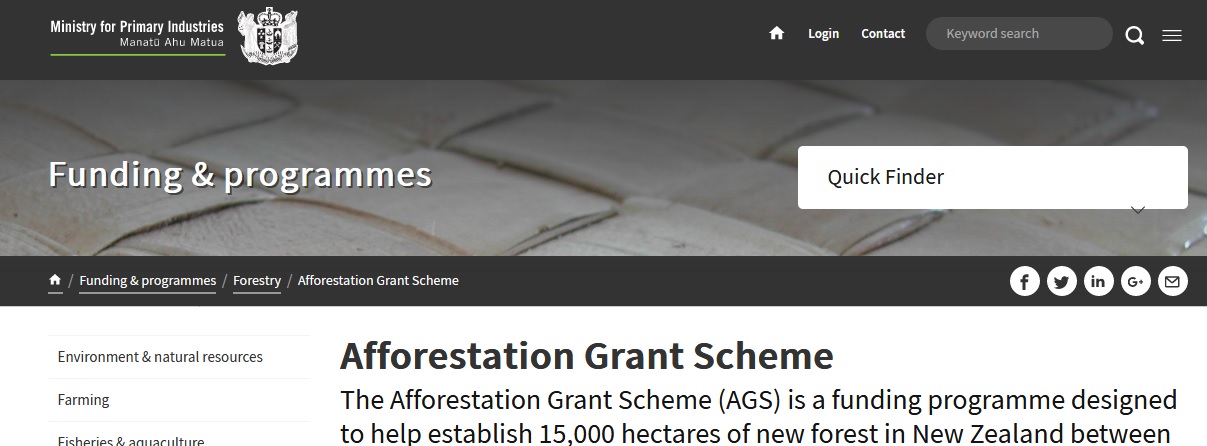mpi.govt.nz Afforestation Grant Scheme New Zealand : Ministry for Primary Industries
Organization : Ministry for Primary Industries
Service Name : Afforestation Grant Scheme
Country: New Zealand
| Want to comment on this post? Go to bottom of this page. |
|---|
Website : https://www.mpi.govt.nz/funding-and-programmes/forestry/afforestation-grant-scheme/
MPI Afforestation Grant Scheme
Grants for new forests:
We want 15,000 hectares of new forest planted by 2020, to improve land-use productivity and regional economic development.
Related : Department of Internal Affairs Community Organisation Grants Scheme COGS New Zealand : www.statusin.org/11208.html
The new forests will also give environmental benefits, including reducing soil erosion, storing carbon, and improving water quality. The growing of new forests has declined over the decades – from 55,000 hectares a year in the 1990s to just 3,000 in 2014. In addition, we estimate that 1.1 million hectares of land is at serious risk of erosion and forest cover is the best form erosion control.

To help reach this goal, we’re providing grants of $1,300 a hectare (to a total of $19.5 million) to help people plant new forests. In return, the Crown will get the carbon credits. People must commit to maintaining the forest for at least 10 years. MPI will hold 5 funding rounds, one a year until 2019.
Who can apply:
Anyone or any organisation that owns land or has a right to use land for forestry can apply. You can also apply if you’re about to buy the land or gain an interest in the land. You must be able to commit between 5 and 300 hectares of land to planting in new forest.
You can apply to each funding round, as long as you’re applying for a new planting on separate land blocks. If you apply multiple times, we will only fund you for up to 300 hectares over the life of the scheme.
Once MPI receives your application, we:
** will check it for eligibility
** may do a site inspection
** will compare the merits of your application to all the other applications.
If MPI accepts your application, you’ll then have 1 year to establish your forest. We expect planting will happen in the winter following the funding round – so if you apply in 2015, and receive a grant, you’ll be planting in winter 2016.
Once your forest’s established, you can claim your grant. We’ll visit your forest to make sure it’s established to the required standard. If the forest meets the establishment standard, MPI will pay you the grant for the area established. The applicant guidelines have more detail about the standards required.
If you sell or transfer your forest to someone else, you must tell MPI and we will transfer your grant agreement to the new owner.
MPI will monitor your forest over the following 10 years to make sure it’s up to standard. After 10 years, you’re free to do as you choose with your forest.
Eligible land:
Your land can be across more than one title, as long as you own it or have the right to use it. Your application can include more than one parcel of land – each parcel must be bigger than 1 hectare. We’ll prioritise applications to plant erodible pastoral land that are part of a ‘whole farm plan’ that’s been approved by a regional council. (Talk to your local regional council to learn more about farm plans.)
The land must be new forest planting. It can:
** not be ‘forest land’ under the Climate Change Response Act 2002 when you apply
** not have been ‘forest land’ on 31 December 1989
** not have been ‘forest land’ at any time in the 5 years before you apply.
The type of forest you can grow:
You must plant the forest to qualify for a grant, you can’t seed it or let it regenerate naturally. You can use the AGS for commercial or environmental reasons, or both. You have to maintain the forest to a set standard to be eligible for the grant. If you cut down the forest or don’t look after it, you may have to replant or, as a last resort, pay the grant back.
You can plant native or exotic trees. The trees can be a mix of forest species. A forest species is one able to grow to at least 5 metres in the place you’ve planted it – it isn’t a species used mainly for fruit or nut crops.
You still own the trees and timber:
If your forest is funded by a grant, you still own the trees and the timber. However, the government will get the carbon credits for the first 10 years.
How this scheme differs from the old one:
The new scheme builds on the experience MPI gained from running the old scheme. We’ve made the following improvements:
** There’s one funding pool – administered by MPI to be more efficient (rather than 2 funding pools split between MPI and regional councils).
** The grant is fixed – $1,300 a hectare – which gives applicants certainty so they can make informed decisions. The rate is based on the average rate of the previous scheme.
** We’ll prioritise applications on how they benefit the environment, such as reducing soil erosion.
** We’ve excluded forests to be established by seeding or natural reversion.
** Forests will be assessed for their risk of wilding spread. Forests at high risk won’t be eligible.
From 2008 to 2013, more than 12,000 hectares of new forest was planted using the old AGS scheme. Much of the planting was on erosion prone land. This improved water quality and reduced the impact of severe flooding.